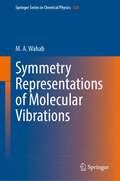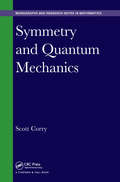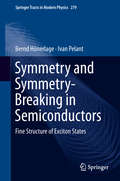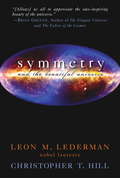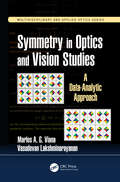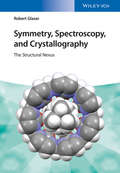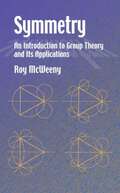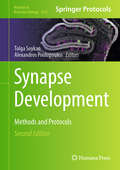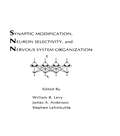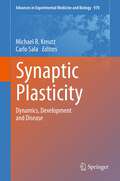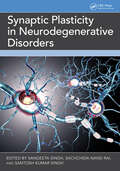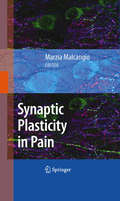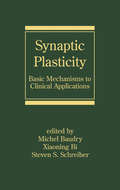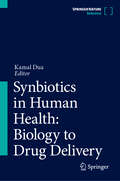- Table View
- List View
Symmetry Representations of Molecular Vibrations (Springer Series in Chemical Physics #126)
by M.A. WahabThis book presents a comprehensive theoretical basis of symmetry representations of molecular vibrations, matrix representation of symmetries, and the elements of group theory that are relevant to other symmetry elements/operations, crystallographic and molecular point groups. The book helps understand the reducible and irreducible representations of symmetry matrices and then derive the normal modes of vibration of different molecules by using suitable techniques independently. Targeted to graduate students and researchers, this book aims not only to derive the normal modes of vibration of any given molecule themselves but also compares and verifies them with the experimentally found modes by using IR and Raman-related techniques. For the first time in the crystallographic history, this book presents the group multiplication tables of all 32 point groups in both international and Schoenflies notations.
Symmetry and Quantum Mechanics (Chapman & Hall/CRC Monographs and Research Notes in Mathematics)
by Scott CorryStructured as a dialogue between a mathematician and a physicist, Symmetry and Quantum Mechanics unites the mathematical topics of this field into a compelling and physically-motivated narrative that focuses on the central role of symmetry. Aimed at advanced undergraduate and beginning graduate students in mathematics with only a minimal background in physics, this title is also useful to physicists seeking a mathematical introduction to the subject. Part I focuses on spin, and covers such topics as Lie groups and algebras, while part II offers an account of position and momentum in the context of the representation theory of the Heisenberg group, along the way providing an informal discussion of fundamental concepts from analysis such as self-adjoint operators on Hilbert space and the Stone-von Neumann Theorem. Mathematical theory is applied to physical examples such as spin-precession in a magnetic field, the harmonic oscillator, the infinite spherical well, and the hydrogen atom.
Symmetry and Symmetry-Breaking in Semiconductors: Fine Structure of Exciton States (Springer Tracts in Modern Physics #279)
by Bernd Hönerlage Ivan PelantThis book discusses group theory investigations of zincblende and wurtzite semiconductors under symmetry-breaking conditions. The text presents the group theory elements required to develop a multitude of symmetry-breaking problems, giving scientists a fast track to bypass the need for recalculating electronic states. The text is not only a valuable resource for speeding up calculations but also illustrates the construction of effective Hamiltonians for a chosen set of electronic states in crystalline semiconductors. Since Hamiltonians have to be invariant under the transformations of the point group, the crystal symmetry determines the multiplet structure of these states in the presence of spin-orbit, crystal-field, or exchange interactions. Symmetry-breaking leads to additional coupling of the states, resulting in shifts and/or splittings of the multiplets. Such interactions may be intrinsic, as in the case of the quasi-particle dispersion, or extrinsic, induced by magnetic, electric, or strain fields. Using a power expansion of the perturbations these interaction terms can be determined in their parameterized form in a unique way. The hierarchic structure of this invariant development allows to estimate the importance of particular symmetry-breaking effects in the Hamiltonian. A number of selected experimental curves are included to illustrate the symmetry-based discussions, which are especially important in optical spectroscopy. This text is written for graduate students and researchers who want to understand and simulate experimental findings reflecting the fine structure of electronic or excitonic states in crystalline semiconductors.
Symmetry and the Beautiful Universe
by Christopher T. Hill Leon M. LedermanWhen scientists peer through a telescope at the distant stars in outer space or use a particle-accelerator to analyze the smallest components of matter, they discover that the same laws of physics govern the whole universe at all times and all places. Physicists call the eternal, ubiquitous constancy of the laws of physics symmetry. Symmetry is the basic underlying principle that defines the laws of nature and hence controls the universe. This all-important insight is one of the great conceptual breakthroughs in modern physics and is the basis of contemporary efforts to discover a grand unified theory to explain all the laws of physics.Nobel Laureate Leon M. Lederman and physicist Christopher T. Hill explain the supremely elegant concept of symmetry and all its profound ramifications to life on Earth and the universe at large in this eloquent, accessible popular science book. They not only clearly describe concepts normally reserved only for physicists and mathematicians, but they also instill an appreciation for the profound beauty of the universe's inherent design.Central to the story of symmetry is an obscure, unpretentious, but extremely gifted German mathematician named Emmy Noether. Though still little known to the world, she impressed no less a scientist than Albert Einstein, who praised her "penetrating mathematical thinking." In some of her earliest work she proved that the law of the conservation of energy was connected to the idea of symmetry and thus laid the mathematical groundwork for what may be the most important concept of modern physics.Lederman and Hill reveal concepts about the universe, based on Noether's work, that are largely unknown to the public and have wide-reaching implications in connection with the Big Bang, Einstein's theory of relativity, quantum mechanics, and many other areas of physics. Through ingenious analogies and illustrations, they bring these astounding notions to life. This book will open your eyes to a universe you never knew existed.From the Trade Paperback edition.
Symmetry in Chemistry
by Hans H. Jaffé Milton OrchinBecause symmetry arguments are a powerful tool in teaching such concepts as hybridization, group and molecular orbitals, selection rules in absorption spectroscopy, crystal structure, and other topics, a book devoted exclusively to symmetry in chemistry, developed in an essentially nonmathematical way, is a must for students and research workers interested in these subjects. This is such a book. After an introduction to symmetry, the authors offer lucid discussions of symmetry elements and operations, multiple symmetry operations, multiplication tables and point groups, group theory, applications, and crystal symmetry. Three appendices provide complete character tables, tables of the number of normal vibrations in various symmetry species, and tables showing the direct sums of excited states and combination states of degenerate vibrations. Intended as a supplementary text for both undergraduate and graduate students who seek a broad background for understanding structural problems, this concise treatment will also appeal to the large group of practicing chemists who wish to review the applications of symmetry and group theory.
Symmetry in Inorganic and Coordination Compounds: A Student's Guide to Understanding Electronic Structure (Lecture Notes in Chemistry #106)
by Franca MorazzoniThis book addresses the nature of the chemical bond in inorganic and coordination compounds. In particular, it explains how general symmetry rules can describe chemical bond of simple inorganic molecules. Since the complexity of studying even simple molecules requires approximate methods, this book introduces a quantum mechanical treatment taking into account the geometric peculiarities of the chemical compound. In the case of inorganic molecules, a convenient approximation comes from symmetry, which constrains both the electronic energies and the chemical bonds. The book also gives special emphasis on symmetry rules and compares the use of symmetry operators with that of Hamiltonian operators. Where possible, the reactivity of molecules is also rationalized in terms of these symmetry properties. As practical examples, electronic spectroscopy and magnetism give experimental confirmation of the predicted electronic energy levels.Adapted from university lecture course notes, this book is the ideal companion for any inorganic chemistry course dealing with group theory.
Symmetry in Optics and Vision Studies: A Data-Analytic Approach (Multidisciplinary and Applied Optics)
by Vasudevan Lakshminarayanan Marlos A.G. VianaThis book presents an introduction to the foundations, interpretations, and data-analytic applications of symmetry studies with an emphasis on applications in optical sciences. Symmetry studies connect group theoretic and statistical methods for data summary and inference. Readers should have an understanding of calculus and linear algebra as well as introductory statistics. The book reviews finite group theory in the introductory chapters. Computational tools used in the text are available for download in the form of Mathmaticaâ notebooks or R scripts. This book: Demonstrates the usefulness of a unified view of algebra and symmetry studies to address data-analytic questions in optics and vision science Offers a brief review of finite group theory and elements of multivariate analysis Includes various examples from diverse areas of optical science
Symmetry through the Eyes of a Chemist
by Istvan Hargittai Magdolna HargittaiThis is the first book to comprehensively survey chemistry from the point of view of symmetry. It contains many examples from chemistry as well as from other fields which emphasize the unifying nature of the symmetry concept.
Symmetry, Group Theory, and the Physical Properties of Crystals
by Richard C PowellThis book demonstrates the importance of symmetry in determining the properties of solids and the power of using group theory and tensor algebra to elucidate these properties. It provides the fundamentals necessary for the reader to understand how to utilize these techniques in many different applications without becoming lost in a heavy formal treatment of the subject matter. The book begins by discussing the concepts of symmetry relevant to crystal structures. This is followed by a summary of the basics of group theory and how it applies to quantum mechanics. Next is a discussion of the description of the macroscopic properties of crystals by tensors and how symmetry determines the form of these tensors. The basic concepts covered in these early chapters are then applied to a series of different examples including crystal field theory treatment of point defects in solids, molecular orbitals, two-photon processes, the optical properties of solids, the nonlinear optical properties of solids, lattice vibrations, the Jahn-Teller effect, and the effects of translational symmetry on electronic energy bands in solids.. Emphasis is placed on showing how group theory and tensor algebra can provide important information about the properties of a system without resorting to first principal quantum mechanical calculations. The book also features a comprehensive set of relevant tables, including crystal symmetries, point group character tables, matter tensors of different rank, and other tensor properties.
Symmetry, Spectroscopy, and Crystallography
by Robert GlaserWritten in a clear and understandable manner, this book provides a comprehensive, yet non-mathematical, treatment of the topic, covering the basic principles of symmetry and the important spectroscopic techniques used to probe molecular structure. The chapters are extensively illustrated and deal with such topics as symmetry elements, operations and descriptors, symmetry guidelines, high-fidelity pseudosymmetry, crystallographic symmetry, molecular gears, and experimental techniques, including X-ray crystallography and NMR spectroscopy. As an additional feature, 3D animations of most of the structures and molecules covered are available online at wiley.com. As a result, chemists learn how to understand and predict molecular structures and reactivity. Authored by a renowned expert with numerous publications and an excellent track record in research and teaching, this is a useful source for graduate students and researchers working in the field of organic synthesis, physical chemistry, biochemistry, and crystallography, while equally serving as supplementary reading for courses on stereochemistry, organic synthesis, or crystallography.
Symmetry: An Introduction to Group Theory and Its Applications
by Roy McweenyThe crucial significance of symmetry to the development of group theory and in the fields of physics and chemistry cannot be overstated, and this well-organized volume provides an excellent introduction to the topic.The text develops the elementary ideas of both group theory and representation theory in a progressive and thorough fashion, leading students to a point from which they can proceed easily to more elaborate applications. The finite groups describing the symmetry of regular polyhedral and of repeating patterns are emphasized, and geometric illustrations of all main processes appear here -- including more than 100 fully worked examples.Designed to be read at a variety of levels and to allow students to focus on any of the main fields of application, this volume is geared toward advanced undergraduate and graduate physics and chemistry students with the requisite mathematical background.
Symphony in C (Almost) Everything: Carbon And The Evolution Of (almost) Everything
by Robert M. HazenA Science News Favorite Book of 2019 An earth scientist reveals the dynamic biography of the most resonant—and most necessary—chemical element on Earth. Carbon. It’s in the fibers in your hair, the timbers in your walls, the food that you eat, and the air that you breathe. It’s worth billions of dollars as a luxury and half a trillion as a necessity, but there are still mysteries about the element that can be both diamond and coal. Where does it come from, what does it do, and why, above all, does life need it? With poetic storytelling, Robert M. Hazen leads us on a global journey through the origin and evolution of life’s most essential and ubiquitous element.
Symplasmic Transport in Vascular Plants
by Katarzyna Sokołowska Paweł SowińskiConcentrates on symplasmic transport of small molecules, although the cell-to-cell transport of macromolecules will also be discussed. This book characterize the efficiency of symplasmic transport, mechanisms of molecule passage via plasmodesmata, and the external and internal factors that regulate plasmodesmatal conductivity. In this context, the book focused on the role of symplasmic domains in plant development, as well as the influence of environmental stresses on the plasmodesmata. Besides cell-to-cell symplasmic transport, the significance of long-distance symplasmic transport of solutes in phloem elements is also reviewed. Symplasmic Transport in Vascular Plants presents the mechanism of phloem transport, the processes of symplasmic loading and unloading, as well as the role of pre- and post-phloem transport, with special attention paid to symplasmic transport in wood. Finally, the relevance of the spread of both macromolecules and viruses, via plasmodesmata, is presented.
Symplectic Topology and Floer Homology
by Yong-Geun OhPublished in two volumes, this is the first book to provide a thorough and systematic explanation of symplectic topology, and the analytical details and techniques used in applying the machinery arising from Floer theory as a whole. Volume 2 provides a comprehensive introduction to both Hamiltonian Floer theory and Lagrangian Floer theory, including many examples of their applications to various problems in symplectic topology. The first volume covered the basic materials of Hamiltonian dynamics and symplectic geometry and the analytic foundations of Gromov's pseudoholomorphic curve theory. Symplectic Topology and Floer Homology is a comprehensive resource suitable for experts and newcomers alike.
Synapse Development: Methods and Protocols (Methods in Molecular Biology #2910)
by Alexandros Poulopoulos Tolga SoykanThis fully updated volume brings together synapse development methods that span from the macroscopic to the nanoscale in order to foster novel perspectives and encourage interdisciplinary integration. Beginning with a section on in vitro formation and manipulation of synapses, including cutting-edge approaches for neuron differentiation and genomic modification, the book continues by covering methods for dissecting synaptic components at high resolution, utilizing advanced imaging and purification techniques, as well as approaches for studying synaptic networks and activity patterns in their native contexts, featuring methods for labeling, tracing, and quantifying components of developing neural circuits. Written for the highly successful Methods in Molecular Biology series, chapters include introductions to their respective topics, lists of the necessary materials and reagents, step-by-step and readily reproducible laboratory protocols, and tips on troubleshooting and avoiding known pitfalls. Authoritative and up-to-date, Synapse Development: Methods and Protocols, Second Edition serves as valuable resource for researchers seeking to advancing our understanding of how synapses form, transform, and transmit.
Synaptic Mechanisms in the Auditory System
by Arthur N. Popper Richard R. Fay Laurence O. TrussellSynaptic Mechanisms in the Auditory System will provide a basic reference for students, clinicians, and researchers on how synapses in the auditory system function to encode acoustic signals. These mechanisms are the groundwork for all auditory processing, and understanding them requires knowledge of the microphysiology of synapses, cellular biophysics, receptor pharmacology, and an appreciation for what these synapses must do for a living, what unique jobs they carry out.
Synaptic Modification, Neuron Selectivity, and Nervous System Organization
by William B. Levy, James A. Anderson and Stephen LehmkuhleFirst published in 1985. Routledge is an imprint of Taylor & Francis, an informa company.
Synaptic Plasticity
by Michael R. Kreutz Carlo SalaThis book introduces the current concepts of molecular mechanisms in synaptic plasticity and provides a comprehensive overview of cutting-edge research technology used to investigate the molecular dynamics of the synapses. It explores current concepts on activity-dependent remodeling of the synaptic cytoskeleton and presents the latest ideas on the different forms of plasticity in synapses and dendrites. Synaptic Plasticity in Health and Disease not only supplies readers with extensive knowledge on the latest developments in research, but also with important information on clinical and applied aspects. Changes in spine synapses in different brain disease states, so-called synaptopathies, are explained and described by experts in the field. By outlining basic research findings as well as physiological and pathophysiological impacts on synaptic plasticity, the book represents an essential state-of-the-art work for scientists in the fields of biochemistry, molecular biology and the neurosciences, as well as for doctors in neurology and psychiatry alike.
Synaptic Plasticity in Neurodegenerative Disorders
by Sangeeta Singh Santosh Kumar Singh Sachchida Nand RaiThis book explores the pivotal role of synaptic plasticity in the pathogenesis, progression, and potential treatment of neurodegenerative disorders. The initial chapter provides an in-depth understanding of the complexity and impact of neurodegenerative conditions. It discusses the association of mitochondrial dysfunction, epigenetic influences, and neuroinflammation with synaptic plasticity in neurodegenerative diseases. The following chapters review the dynamic changes that occur at the cellular and synaptic levels in Parkinson's disease, Alzheimer's disease, and Huntington's disease, paving the way for innovative therapeutic strategies. Furthermore, the book presents various computational tools and methodologies essential for enhancing our understanding of synaptic plasticity. It examines the transformative role of artificial intelligence tools in addressing synaptic impairment across various neurodegenerative diseases. Discusses the role of synaptic plasticity in neurodegenerative diseases, shedding light on how dynamic changes occur at the cellular and synaptic levels Explores the transformative role of artificial intelligence tools in addressing synaptic impairment across various neurodegenerative diseases Provides a comprehensive overview of neurodegenerative disorders, including pathogenesis, etiology, and treatment strategies Presents tools and techniques used to simulate the complex system biology of synaptic plasticity Examines the role of computational neuroscience in understanding and potentially treating conditions such as multiple sclerosis and amyotrophic lateral sclerosis Toward the end, the book explores the role of synaptic impairment and computational neuroscience in understanding and potentially treating conditions such as multiple sclerosis and amyotrophic lateral sclerosis. With its multifaceted approach, this book serves as a useful resource for researchers, clinicians, and students in the fields of neuroscience, computational biology, and neurology.
Synaptic Plasticity in Pain
by Marzia MalcangioPrimary sensory neurons respond to peripheral stimulation and project to the spinal cord. Specifically, the population of neurons which respond to damaging stimuli terminate in the superficial layers of the dorsal horn. Therefore, the dorsal horns constitute the first relay site for nociceptive fibre terminals which make synaptic contacts with second order neurons. It has recently become clear that the strength of this first pain synapse is plastic and modifiable by several modulators, including neuronal and non-neuronal regulators, and studies on the fundamental processes regulating the plasticity of the first pain synapse have resulted in the identification of new targets for the treatment of chronic pain. This book will be of interest to a wide readership in the pain field.
Synaptic Plasticity: Basic Mechanisms to Clinical Applications (Neurological Disease and Therapy)
by Michel Baudry Xiaoning Bi Steven S. SchreiberThis reference provides a clear understanding of the basic mechanisms of synaptic transmission and information processing and illustrates potential clinical applications for the recovery of lost function as a result of gene defects, injury, or disease-relating the most recent advances in the design of new therapeutics, the treatment of neurological
Synaptic Self: How Our Brains Become Who We Are
by Joseph LedouxIn 1996 Joseph LeDoux's The Emotional Brain presented a revelatory examination of the biological bases of our emotions and memories. Now, the world-renowned expert on the brain has produced with a groundbreaking work that tells a more profound story: how the little spaces between the neurons—the brain's synapses—are the channels through which we think, act, imagine, feel, and remember. Synapses encode the essence of personality, enabling each of us to function as a distinctive, integrated individual from moment to moment. Exploring the functioning of memory, the synaptic basis of mental illness and drug addiction, and the mechanism of self-awareness, Synaptic Self is a provocative and mind-expanding work that is destined to become a classic. .
Synaptic Tagging and Capture: From Synapses to Behavior
by Sreedharan Sajikumar Ted AbelThis reference presents a detailed exploration of the synaptic tagging and capture model, which has been proposed to provide a conceptual basis for how short-term memories are transformed into long-term memories. The first edition of Synaptic Tagging and Capture served as a comprehensive introduction and overview of the field and covered the topics from molecular and cellular aspects to behavior. This second edition reflects the overwhelming amount of research on the topic in the past five years. Notably, it provides greater insight into the molecular and cellular mechanisms and behavioral aspects of tagging and capture, including reconsolidation, computational, and metaplastic models. Synaptic Tagging and Capture: From Synapses to Behavior, 2nd edition remains the definitive work in the field.
Synbiotics in Human Health: Biology to Drug Delivery
by Kamal DuaThis reference book discusses the role of synbiotics in a wide range of disease states, including cardiovascular, reproductive, metabolic, neurodegenerative, gastrointestinal, thrombotic, skin, and inflammatory disorders. It reviews the functions of probiotics in the diagnosis, prevention, or treatment of various disease states. The book further covers improving the targeting efficiency of synbiotics through advanced drug delivery systems such as nanoparticles, microparticles, liposomes, microemulsion, solid lipid nanoparticles, and nano lipid carriers. The chapter addresses the implications of oral and topical delivery of synbiotics in different diseases and presents the safety assessment of synbiotics and clinical trials associated with synbiotics containing drug delivery systems for the treatment of diseases. The book also explores the synergistic welfare of synbiotics nutraceuticals in various conditions such as chronic respiratory diseases, gut health, and neurological functions and examines the toxicological profile, and regulatory aspects of nutraceutical supplements. As such, this book is a valuable resource for academics, research and industry professionals working in Pharmaceutical Sciences, Food Biotechnology, Immunology, and Health Sciences.
Sync: How Order Emerges from Chaos In the Universe, Nature, and Daily Life
by Steven H. StrogatzAt the heart of the universe is a steady, insistent beat, the sound of cycles in sync. Along the tidal rivers of Malaysia, thousands of fireflies congregate and flash in unison; the moon spins in perfect resonance with its orbit around the earth; our hearts depend on the synchronous firing of ten thousand pacemaker cells. While the forces that synchronize the flashing of fireflies may seem to have nothing to do with our heart cells, there is in fact a deep connection.Synchrony is a science in its infancy, and Strogatz is a pioneer in this new frontier in which mathematicians and physicists attempt to pinpoint just how spontaneous order emerges from chaos. From underground caves in Texas where a French scientist spent six months alone tracking his sleep-wake cycle, to the home of a Dutch physicist who in 1665 discovered two of his pendulum clocks swinging in perfect time, this fascinating book spans disciplines, continents, and centuries. Engagingly written for readers of books such as Chaos and The Elegant Universe, Sync is a tour-de-force of nonfiction writing.
